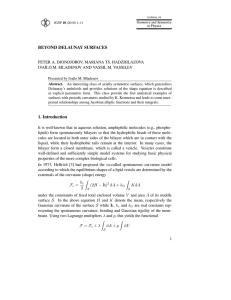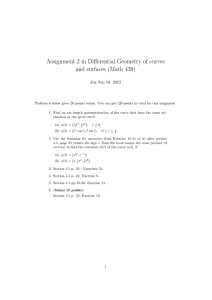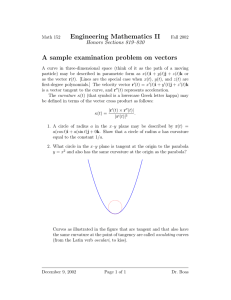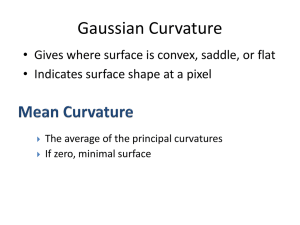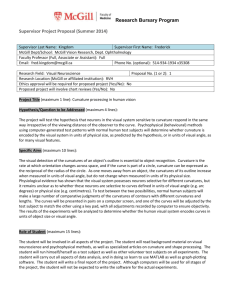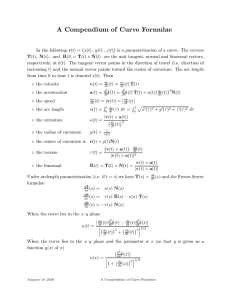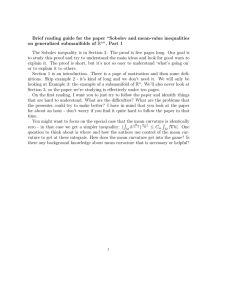MA 323 Geometric Modelling Course Notes: Day 25 David L. Finn
advertisement
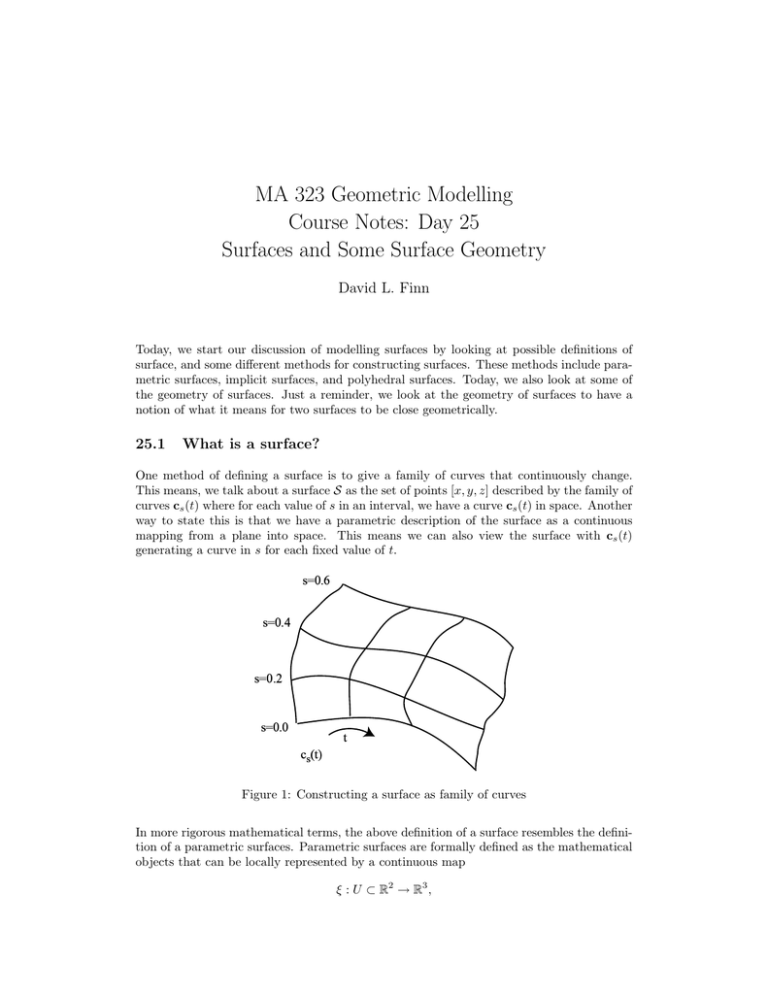
MA 323 Geometric Modelling
Course Notes: Day 25
Surfaces and Some Surface Geometry
David L. Finn
Today, we start our discussion of modelling surfaces by looking at possible definitions of
surface, and some different methods for constructing surfaces. These methods include parametric surfaces, implicit surfaces, and polyhedral surfaces. Today, we also look at some of
the geometry of surfaces. Just a reminder, we look at the geometry of surfaces to have a
notion of what it means for two surfaces to be close geometrically.
25.1
What is a surface?
One method of defining a surface is to give a family of curves that continuously change.
This means, we talk about a surface S as the set of points [x, y, z] described by the family of
curves cs (t) where for each value of s in an interval, we have a curve cs (t) in space. Another
way to state this is that we have a parametric description of the surface as a continuous
mapping from a plane into space. This means we can also view the surface with cs (t)
generating a curve in s for each fixed value of t.
Figure 1: Constructing a surface as family of curves
In more rigorous mathematical terms, the above definition of a surface resembles the definition of a parametric surfaces. Parametric surfaces are formally defined as the mathematical
objects that can be locally represented by a continuous map
ξ : U ⊂ R2 → R3 ,
25-2
that is can be represented as
ξ(u, v) = [f (u, v), g(u, v), h(u, v)]
where f , g, h are continuous in the both variables u and v and the variables (u, v) ∈
[a, b] × [c, d]. There are some problems with this definition and the construction of a surface
as a one parameter family of curves, as it can create some objects that one may not to call
a surface. For instance, this definition does not prevent self-intersections of the surface, see
diagram below.
Figure 2: Problem with parametric surface
The method for fixing the definition of a parametric surface to prevent self-intersections is to
define an embedded surface. This definition requires that the surface be obtained locally as a
continuous deformation of a plane in space. This means that the surface is locally described
as the image of a continuous map ξ : R3 → R3 restricted to a plane, and moreover the map
ξ must have a continuous inverse. The continuous inverse and the extra dimension prevent
self-intersections for this definition of a surface. A way to view the difference between an
embedded surface and a parametric surface is the difference between viewing the surface as
consisting locally of a single piece of paper or specific piece of paper within a ream of paper,
see diagrams below.
Is this the only method for creating a surface? Of course not, but it is the natural method
given our methods for creating curves. Other methods require using three-dimensional
geometric constructions. There are several different methods that can be used. One is
constructive solid geometry where one constructs an approximation of the object using very
simple objects; rectangular solids, prisms, spheres, cones, and cylinders with a notion of
adding two objects and subtracting two objects (union, intersection and difference in a set
theoretic manner) and other methods for blending or smoothing. We will not discuss this
method further. Another option is to construct a general polyhedral approximation. A
polyhedron is the three-dimensional analogue of polygon. Once one polyhedron has been
25-3
Figure 3: Parametric Surface vs Embedded Surface
constructed, we apply an iterative algorithm to refine the approximation, by essentially
cutting corners off the polyhedron to create a better polyhedral approximation. We will
examine this type of construction after we look at different types of constructing surfaces
by generalizing curve constructions.
Other methods exist for creating surfaces exploiting different mathematical structures. For
instance, one can define a surface as the level set of a function f (x, y, z), that is the set
of points {(x, y, z) : f (x, y, z) = c}. This type of surface is normally built out of a small
collection of function types ek (x, y, z) each of which generates a special type of level set,
and then considers the level sets of functions of type
XX j
f (x, y, z) =
ai ej (x − xji , y − yij , z − zij )
j
i
where the numbers aji control the relative importance of the function ej (x−xji , y −yij , z −zij )
in the function f (x, y, z) and the points (xji , yij , zij ) translate where the level sets of ei (x, y, z)
are located. This type of construction is very similar to the constructions of constructive
solid geometry, except that the set theoretic approach is encapsulated in building the function f from the base functions ek .
25.2
Surface Patches
The creation methods that we will first be using for surfaces involve generalizing the curve
methods we have discussed already to create parametric surfaces. We note that all the
curve methods (Bezier curves, Hermite curves, Bezier splines, B-splines) that we described
can be used to generate surfaces. We will concentrate on the methods using Bezier curve
ideas. Our main goal for today is to develop the conceptual ideas for creating surfaces as a
collection of surface patches.
What is a surface patch? A surface patch is a generalization of a curve segment. The way
to view a patch is to think of an embedded surface as a patchwork quilt. A patchwork quilt
25-4
is built from small (rectangular) elements that are sewn together to create a shape. You
could also view the creation of a surface in this manner as making clothes or Frankenstein
- whose body was sewn together from smaller pieces.
Mathematically, a (rectangular) patch is a mapping x(u, v) from the unit square 0 ≤ u ≤ 1
and 0 ≤ v ≤ 1 to a surface in space. The boundaries of the square in the uv plane (the lines
u = 0, u = 1, v = 0, v = 1) become curves in space. See diagram below. More over each
individual line u = constant and v = constant generates a curve in space.
Figure 4: A rectangular patch
A surface can be viewed as a collection of patches that are joined together to form a larger
surface. The intricate part of creating surfaces in this manner comes from joining surface
patches together. The individual surface patches can be created easily by generalizing some
of the curve methods, but joining the surfaces together is not as easy as joining curves
together.
Figure 5: Joining rectangular patches
25-5
25.3
Surface Geometry
Today, we also want to discuss the shape of a surface. Recall, that the shape of a plane
curve is uniquely determined by the curvature of a curve. The shape of a space curve is
given by a curvature (rate of change of the unit tangent vector) and a torsion (the rate of
change of the orthogonal frame). However, the shape of a surface is more complicated. It is
not uniquely determined by any set of functions. We must at least give a curvature function
and a boundary curve.
To determine the shape of a surface, we need two curvatures. The general method is to
compute the unit normal vector of the surface, and then compute the rate of change of the
normal vector in different directions. The question is what directions? Does it matter which
directions?
Given a parametric surface S described as x(u, v). The normal vector is given as n = tu ×tv ,
where tu is the unit tangent vector in the u-direction and tv is the unit tangent vector in
the v-direction. The unit normal vector to the surface is well defined provided the partial
derivatives ∂x/∂u and ∂x/∂v are linearly independent, i.e. not scalar multiplies of each
other, which means the tangent plane of the surface is well-defined. To define the curvature,
we need the unit normal well-defined at each point p, moreover we need a consistent choice
of this unit normal. This means that the unit normal n(u, v) must be continuous or always
point on the same side of the surface.
Figure 6: Geometry of surfaces
We compute the curvatures of a surface in the following manner. Given a point p, compute
the unit normal n vector at p. Each unit tangent t in the tangent plane, consider the curve
ct defined as the intersection of the surface S and the plane through p containing the vector
t and n, (see diagram below). Orient this curve so that the vector t is the unit tangent
vector of ct at p, then compute the second derivative of ct with respect to arclength (the
derivative of the unit tangent vector with respect to arclength). This second derivative is a
25-6
multiple of n, for n is a normal vector of the plane curve. This multiplicative factor is the
curvature of the surface at p in the direction t, κ(t). We thus have a curvature for each
direction in the tangent plane.
Figure 7: Curvature at a point p in the direction of t
The directions in the tangent plane are equivalent to a circle. Thus, we have a function κ
on the circle. This function attains a maximum value and a minimum value. The directions
at which the maximum and minimum are attained are called the principle directions. A
theorem of Euler states that the maximum and minimum values of the curvature κ1 and
κ2 occur in orthogonal directions t1 and t2 , and another theorem of Euler states that the
curvatures in the other directions are obtained as a combination of these two curvatures,
κt = cos2 (θ) κ1 + sin2 (θ) κ2 ,
where θ is the angle between t and t2 . The maximum and minimum curvatures κ1 and
κ2 are called the principle curvatures. The local shape of a surface is determined by the
principal curvature. In particular, if κ1 and κ2 have the same sign the surface locally looks
like an ellipsoid (and is called elliptic near such points) and if κ1 and κ2 have opposite signs
the surface locally looks like a hyperboloid, see diagrams below.
Using the principle curvatures, we define other curvatures for a surface. Mathematically,
there are two important curvatures, the mean curvature (the average of the principle curvatures),
1
mean curvature:κmean = (κ1 + κ2 )
2
and the Gauss curvature (the product of the principle curvatures)
Gauss curvature: κGauss = κ1 κ2 .
In geometric modelling, neither of these two curvatures provide the correct measure of shape.
The measure of curvature that is employed in geometric modelling is either the root mean
25-7
Figure 8: Elliptic and Hyperbolic points on surfaces
curvature
q
RMC (root mean curvature): κRM C =
κ21 + κ22 ,
the square root of the sum of the principle curvatures squared or the absolute curvature,
ABS (absolute curvature): κabs = |κ1 | + |κ2 |
the sum of the absolute values of the principal curvatures.
We will not get into the technical details of computing the curvatures. Rather, we want to
try to understand what the curvatures tell us and why we should care about curvature. We
will focus on the root mean curvature. This curvature measures the deviation of the surface
from a plane, as a surface with zero root mean curvature is a plane. Higher root mean
curvature implies that the surface normal is changing very quickly in a small area. While
small root mean curvature means that the surface normal is changing slowly. The problem
with root mean curvature is that it does not tell you which direction the surface is curved,
see diagrams below. For that, one has to look at the principal curvatures, individually.
The first use of curvature is to detect where to place control points or data points for
interpolation. We need to use more control points or data points in regions of high curvature,
and we need to use fewer control points to create a region of low curvature. The other uses of
curvature are to analyze the interaction of the object in its surroundings, and to determine
whether more analysis is needed. In fact, curvature is used in some rendering programs to
aid in ray-tracing. Curvature is also used to create texture maps, especially by coloring by
curvature.
For production purposes, rapidly changing surfaces normals are normally bad in terms of
production. It is normally harder to produce such a surface and it normally costs more. For
instance, in designing a car, a plane, or a ship, rapidly changing surface normals generally
introduce a higher drag coefficient. There generally must be an advantage in producing
a highly curved surface to offset the penalties. Curvature is also used to detects faults
in production, as a ding or other production defect will alter the curvature. To detect
curvature, a standard technique is light interaction. The interaction of light with an object
25-8
Exercises
1. Create several parametric surfaces and use the Maple Code in surfcurv.mws to investigate the general properties of the different curvatures associated with a surface.
For each you have to choose a range to set the maxmimum and minimum curvatures
to plot.
• Color surface by mean curvature.
• Color surface by Gauss curvature
• Color surface by maximum principal curvature
• Color surface by minimum principal curvature
• Color surface by root mean curvature
• Color surface by absolute mean curvature.
(a) Which curvatures best distinguish how the surface is curved?
(b) Can you predict how the surface is curved?
2. For each curvature function below, could two different surfaces generate the same
curvature? If so, describe the two surfaces
(a) Gauss curvature.
(b) Mean curvature.
(c) Maximum principal curvature.
(d) Root Mean Curvature.
